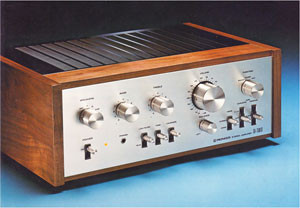The Pioneer SA-7500 is a vintage stereo integrated amplifier that emerged from Pioneer’s renowned audio engineering in the mid-1970s (specifically 1975-78). This amplifier is designed as a 2-channel system, catering to audiophiles who appreciate the warmth and depth of classic analog sound. It’s built to accommodate a comprehensive home audio setup, featuring multiple inputs for various audio sources. Specifically, it includes inputs for two turntables, allowing vinyl enthusiasts to connect multiple record players. Alongside, it provides connectivity for a tuner for radio listening, an auxiliary input for modern devices, and two tape loops for recording and playback through tape decks.
 Pioneer SA-7500 Stereo Integrated Amplifier Front View
Pioneer SA-7500 Stereo Integrated Amplifier Front View
Unpacking the Specifications of the Pioneer SA-7500
Interestingly, the provided specifications detail two slightly different versions of the Pioneer SA-7500, potentially indicating revisions or models released during its production run. The first specification set lists a power output of 40 watts per channel into 8 ohms, with a frequency response spanning from 10Hz to 50kHz. The total harmonic distortion is rated at 0.3%, and the damping factor is 25. Input sensitivity is specified as 7.5mV for microphone, 2.5mV for moving magnet (MM) phono cartridges, and 150mV for line-level inputs. Signal-to-noise ratios are 65dB for microphone, 70dB for MM phono, and 90dB for line inputs. It also includes outputs for line (150mV), DIN (30mV), and pre-out (1V). Internally, this version utilizes 2 FETs, 35 transistors, and 21 diodes. It measures 420 x 150 x 345mm and weighs 12kg, dating back to 1976.
The second specification set indicates a slight upgrade, possibly representing the Pioneer SA-7500 II model. This version offers a slightly higher power output of 45 watts per channel into 8 ohms. The frequency response is slightly narrower, ranging from 10Hz to 40kHz, but boasts a lower total harmonic distortion of 0.1% and an improved damping factor of 30. Input sensitivities remain at 2.5mV (MM) and 150mV (line). Signal-to-noise ratios are enhanced to 73dB for MM phono and 95dB for line inputs. Output options are listed as 150mV (line). This iteration uses a different semiconductor configuration with 2 ICs, 26 transistors, and 17 diodes. It is also more compact and lighter, with dimensions of 380 x 139 x 308mm and a weight of 9.1kg, also from 1976. These subtle differences highlight potential refinements made during the SA-7500’s production timeline.
User Reviews and Performance Insights
User reviews offer valuable real-world perspectives on the Pioneer SA-7500’s performance and characteristics. Reviewers consistently praise its robust build quality and surprisingly potent sound for its age. Many users note that it seems to deliver power beyond its 40-45 watt rating, characterized by a punchy and detailed sound output. The soundstage is often described as wide and detailed, contributing to an immersive listening experience. One reviewer, Hillbillycat71, specifically mentions its “punch and very good detail,” and acknowledges that 1970s Pioneer equipment was not just about aesthetics but also about sound quality.
Benny89, reviewing the MK2 version, highlights its “rich and detailed highs and nice lows” and notes the absence of clipping or distortion across various inputs, including turntable, PC, and with an equalizer. This user emphasizes the amplifier’s simplicity and value for its performance, suggesting it represents excellent value within its class and era.
Another user, fet_thunderdome, using the MK2 in a setup with various high-quality components, describes the sound as “very well balanced, powerful and very low distortion.” This reviewer appreciates its smooth operation, though notes the slightly narrower physical dimensions compared to other classic components, a point echoed in the specifications differentiating the two versions.
However, not all feedback is solely positive. One review mentions “some problems with the protection circuit,” indicating potential maintenance needs typical of vintage electronics. Another reviewer, boke, while praising the “awesome amp” and its “modern-sounding wide soundstage,” points out the use of “cheap potentiometers” for bias and offset adjustments in the original MK1 version, recommending replacement with higher quality components for improved stability and ease of adjustment. This user also expresses a preference for the original MK1 over the MK2, citing a superior phono-stage and overall construction in the earlier model.
Conclusion: The Enduring Appeal of the Pioneer SA-7500
The Pioneer SA-7500 stands as a testament to the quality and design of 1970s audio equipment. Its robust construction, versatile input options, and well-regarded sound performance make it a desirable piece for vintage audio enthusiasts. While there are subtle variations between different iterations, potentially including the MK1 and MK2 models, user reviews generally agree on its strong sonic capabilities, particularly for its age and original market positioning. Potential buyers should be aware of the typical maintenance considerations for vintage amplifiers, such as component aging and the possibility of needing to address issues like potentiometer quality or protection circuits. Nevertheless, for those seeking a classic stereo listening experience, the Pioneer SA-7500 remains a highly regarded and capable integrated amplifier.
